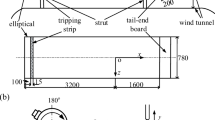Abstract
In experiments using hot wires near the wall, it is well known that wall interference effects between the hot wire and the wall give rise to errors, and mean velocity data from the viscous sublayer can usually not be used to determine the wall position, nor the friction velocity from the linear velocity distribution. Here, we introduce a new method that takes advantage of the similarity of the probability density distributions (PDF) or rather the cumulative distribution functions (CDF) in the near-wall region. By using the velocity data in the CDF in a novel way, it is possible to circumvent the problem associated with heat transfer to the wall and to accurately determine both the wall position and the friction velocity. Prior to its exploitation, the self-similarity of the distribution functions of the streamwise velocity fluctuations within the viscous sublayer is established, and it is shown that they can accurately be described by a lognormal distribution.











Similar content being viewed by others
Notes
The situation for pipe flows is, due to the lack of both resolved experimental and numerical data spanning a sufficient Reynolds number range, unclear (Hultmark et al. 2010), although the recent pipe flow DNS by Wu and Moin (2009) indicates an increase in the limiting values with increasing Reynolds number.
Equivalently, the lognormal distribution parameters, μ and σ, can be obtained through the mean and variance of the PDF, viz. \(\mu=\ln(\rm{mean}^2/\sqrt{\rm{var}+\rm{mean}^2})\) and \(\sigma=\sqrt{\ln(\rm{var}/\rm{mean}^2+1)}\).
References
Abe H, Kawamura H, Choi H (2004) Very large-scale structures and their effects on the wall shear-stress fluctuations in a turbulent channel flow up to Re τ = 640. J Fluid Eng 126:835–846
Alfredsson PH, Johansson AV, Haritonidis J, Eckelmann H (1988) The fluctuating wall-shear stress and the velocity field in the viscous sublayer. Phys Fluids 31:1026–1033
Alfredsson PH, Örlü R (2010) The diagnostic plot–a litmus test for wall bounded turbulence data. Eur J Mech B-Fluid 29:403–406
Barndorff-Nielsen O (1979) Models for non-Gaussian variation, with applications to turbulence. Proc R Soc London Ser A 368:501–520
Bhatia J, Durst F, Jovanovic J (1982) Corrections of hot-wire anemometer measurements near walls. J Fluid Mech 123:411–431
Brücker C, Spatz J, Schröder W (2005) Feasability study of wall shear stress imaging using microstructured surfaces with flexible micropillars. Exp Fluids 39:464–474
Buschmann MH, Gad-el-Hak M (2010) Kolmogorov scaling of turbulent flow in the vicinity of the wall. Phys D Nonlinear Phenom 239:1288–1295
Buschmann MH, Indinger T, Gad-el-Hak M (2009) Near-wall behavior of turbulent wall-bounded flows. Int J Heat Fluid Flow 30:993–1006
Chevalier M, Schlatter P, Lundbladh A, Henningson DS (2007) SIMSON–a pseudo-spectral solver for incompressible boundary-layer flow. Tech Rep TRITA-MEK 2007:07, Royal Institute of Technology, Stockholm, Sweden
Chew Y, Shi S, Khoo BC (1995) On the numerical near-wall corrections of single hot-wire measurements. Int J Heat Fluid Flow 16:471–476
Durst F, Jovanovic J, Kanevce L et al (1987) Probability density distribution in turbulent wall boundary-layer flows. In: Durst F (eds) Turbulent shear flows 5. Springer, Berlin, pp 197–220
Durst F, Kikura H, Lekakis I, Jovanovic J, Ye Q (1996) Wall shear stress determination from near-wall mean velocity data in turbulent pipe and channel flows. Exp Fluids 20:417–428
Durst F, Zanoun ES (2002) Experimental investigation of near-wall effects on hot-wire measurements. Exp Fluids 33:210–218
Durst F, Zanoun ES, Pashtrapanska M (2001) In situ calibration of hot wires close to highly heat-conducting walls. Exp Fluids 31:103–110
Eckelmann H (1974) The structure of the viscous sublayer and the adjacent wall region in a turbulent channel flow. J Fluid Mech 65:439–459
Fischer M, Jovanovic J, Durst F (2001) Reynolds number effects in the near-wall region of turbulent channel flows. Phys Fluids 13:1755–1767
Große S, Schröder W (2009) High Reynolds number turbulent wind tunnel boundary layer wall-shear stress sensor. J Turbulence 10:1–12
Hebbar K (1980) Wall proximity corrections for hot-wire readings in turbulent flows. DISA Inf 25:15–16
Hultmark M, Bailey SCC, Smits AJ (2010) Scaling of near-wall turbulence in pipe flow. J Fluid Mech 649:103–113
Khoo BC, Chew Y, Li G (1997) Effects of imperfect spatial resolution on turbulence measurements in the very near-wall viscous sublayer region. Exp Fluids 22:327–335
Klewicki JC, Metzger M, Kelner E, Thurlow E (1995) Viscous sublayer flow visualizations at R θ ≅ 1500000. Phys Fluids 7:867–863
Landahl M, Mollo-Christensen E (1992) Turbulence and random processes in fluid mechanics, 2nd ed. Cambridge University Press, Cambridge
Lindgren B, Johansson AV, Tsuji Y (2004) Universality of probability density distributions in the overlap region in high Reynolds number turbulent boundary layers. Phys Fluids 16:2587–2591
Marusic I, Heuer WDC (2007) Reynolds number invariance of the structure inclination angle in wall turbulence. Phys Rev Lett 99:114504
Miyagi N, Kimura M, Shoji H, Saima A, Ho CM, Tung S, Tai YC (2000) Statistical analysis on wall shear stress of turbulent boundary layer in a channel flow using micro-shear stress imager. Int J Heat Fluid Flow 21:576–581
Monin AS, Yaglom AM (1971) Statistical fluid mechanics: mechanics of turbulence. vol. I. MIT Press, Cambridge
Morrison JF, McKeon B, Jiang W, Smits AJ (2004) Scaling of the streamwise velocity component in turbulent pipe flow. J Fluid Mech 508:99–131
Moser RD, Kim J, Mansour N (1999) Direct numerical simulation of turbulent channel flow up to Re τ = 590. Phys Fluids 11:943–945
Naqwi A, Reynolds W (1991) Measurement of turbulent wall velocity gradients using cylindrical waves of laser light. Exp Fluids 10:257–266
Obi S, Inoue K, Furukawa T, Masuda S (1996) Experimental study on the statistics of wall shear stress in turbulent channel flows. Int J Heat Fluid Flow 17:187–192
Oka S, Kostic Z (1972) Influence of wall proximity on hot-wire velocity measurements. DISA Inf 13:29–33
Örlü R (2009) Experimental studies in jet flows and zero pressure-gradient turbulent boundary layers. PhD thesis, Royal Institute of Technology, Stockholm, Sweden
Örlü R, Fransson JHM, Alfredsson PH (2010) On near wall measurements of wall bounded flows—the necessity of an accurate determination of the wall position. Prog Aero Sci 46:353–387
Örlü R, Schlatter P (2011) On the fluctuating wall shear stress in zero pressure-gradient turbulent boundary layer flows. Phys Fluids (in press)
Pailhas G, Barricau P, Touvet Y, Perret L (2009) Friction measurement in zero and adverse pressure-gradient boundary layer using oil droplet interferometric method. Exp Fluids 47:195–207
Rao K, Narasimha R, Narayanan M (1971) The ‘bursting’ phenomenon in a turbulent boundary layer. J Fluid Mech 48:339–352
Rüedi J-D, Duncan R, Imayama S, Chauhan K (2009) Accurate and independent measurements of wall-shear stress in turbulent flows. Bull Am Phys Soc 54:20
Schlatter P, Örlü R (2010) Assessment of direct numerical simulation data of turbulent boundary layers. J Fluid Mech 659:116–126
Schlatter P, Örlü R, Li Q, Brethouwer G, Fransson JHM, Johansson AV, Alfredsson PH, Henningson DS (2009) Turbulent boundary layers up to Re θ = 2500 studied through simulation and experiment. Phys Fluids 21:051702
Smith C, Metzler S (1983) The characteristics of low-speed streaks in the near-wall region of a turbulent boundary layer. J Fluid Mech 129:27–54
Tsuji Y, Nakamura I (1999) Probability density function in the log-law region of low Reynolds number turbulent boundary layer. Phys Fluids 11:647–658
Wenzhong L, Khoo BC, Diao X (2006) The thermal characteristics of a hot wire in a near-wall flow. Int J Heat Mass Transfer 49:905–918
Wu X, Moin P (2006) A direct numerical simulation study on the mean velocity characteristics in turbulent pipe flow. J Fluid Mech 608:81–112
Acknowledgements
Financial support from the Swedish Research Foundation (VR) is gratefully acknowledged. Computer time was provided by SNIC (Swedish National Infrastructure for Computing) with a generous grant by the Knut and Alice Wallenberg (KAW) Foundation.
Author information
Authors and Affiliations
Corresponding author
Rights and permissions
About this article
Cite this article
Alfredsson, P.H., Örlü, R. & Schlatter, P. The viscous sublayer revisited–exploiting self-similarity to determine the wall position and friction velocity. Exp Fluids 51, 271–280 (2011). https://doi.org/10.1007/s00348-011-1048-8
Received:
Revised:
Accepted:
Published:
Issue Date:
DOI: https://doi.org/10.1007/s00348-011-1048-8




